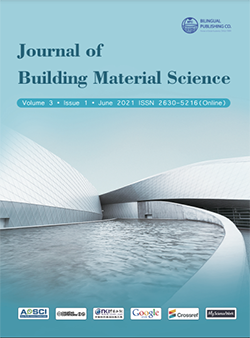-
1742
-
1263
-
1262
-
1151
-
1090
Geotechnical Perspective of the Causes of Cracks in Building of University Campus (Sindh University Jamshoro Sindh Pakistan)
DOI:
https://doi.org/10.30564/jbms.v3i1.3119Abstract
The building construction throughout world faces the defects from normal to heavy and destructive like cracks and fractures which cause damages and eventually collapses to heavy life losses alongside economical and financial. The cracks like structures are found in wall and columns also. For the aim of the study, the international experts have classified the minimum allowable standards of those defects which can not be harmful to buildings and other people living there. This research study has been administered to research the most reasons to research the causes of cracks during a newly completed and used buildings in where some distinct cracks appeared immediately and after some years. Often these cracks seem in almost in walls, columns, beams, and so-like structures having different patterns. the foremost useful and customary methods consisting of reconnaissance survey; building inspection and laboratory testing were wont to investigate the causes of those distinct cracks which will cause the formation of cracks were considered and analyzed by the utilization of reconnaissance survey, factors like width, pattern, and conditions of the cracks were identified during the building inspection stage and therefore the soil properties associated with the creation of cracks were determined during the laboratory test. supported the results of the study; there was no distinct evidence of things like a matured system which will cause the creation of cracks within the building; The pore water pressure during this sort of soil takes longer time to fade, which may be expressed by the very low value of the coefficient of permeability (1.90x 10-7 to 2.15 x 10-7 m/s) acquired from different soil samples collected from the study area. Hence the cracks during this sort of building were found to be caused by the settlement of the building thanks to the character of the predominant soil type that was found within the study area, all the cracks are active cracks with their width increasing with time and therefore the soils within the entire block of the building possessed high percentage of fine materials with high moisture content and plasticity indices.
Keywords:
Buildings, Cracks, Plasticity indices, Coefficient of permeability, Pore water pressure, Moisture content, Differential settlementReferences
[1] .Bell, F.G., 2013. Engineering properties of soils and rocks. Elsevier.
[2] .Boone, S.J., 1996. Ground-movement-related building damage. Journal of geotechnical engineering, 122(11), pp.886-896.
[3] .Boscardin, M.D. and Cording, E.J., 1989. Building response to excavation-induced settlement. Journal of Geotechnical Engineering, 115(1), pp.1-21.
[4] .Bowles, J.E., 1992. Engineering properties of soils and their measurement. McGraw-Hill, Inc.
[5] .BS 1377 (1990): Methods of Test for Soils for Civil Engineering Purposes. British standard Institute.
[6] .BS 8110-1 (1997): Structural use of concrete. Code of practice for design and construction British standard Institute.
[7] .Burland, J.B., Broms, B.B. and DeMello, V.F.B. (1977).“Behaviour of Foundations and Structures: State-of-the Art Report.” Proceedings of the Ninth International Conference on Soil Mechanics and Foundation Engineering, Japanese Geotechnical Society, Tokyo, vol. 2, pp. 495-546.
[8] .Dolinar, B. and Škrabl, S., 2013. Atterberg limits in relation to other properties of fine-grained soils. Acta Geotechnica Slovenica, 10(2), pp.4-13.
[9] .Doshi, S., Patel, D., Patel, K.B., Patel, K.B. and Mavani, P., 2018. Methodology for prevention and repair of cracks in building. GRD Journals-Global Research and Development Journal for Engineering, 3(3), pp.52-57.
[10] .Leonhardt, F., 1988. Cracks and crack control in concrete structures. PCI Journal, 33(4), pp.124-145.
[11] .Nama, P., Jain, A., Srivastava, R. and Bhatia, Y., 2015. Study on causes of cracks & its preventive measures in concrete structures. International Journal of Engineering Research and Applications, 5(5), pp.119-123.
[12] .Okada, S. and Takai, N., 2000, January. Classifications of structural types and damage patterns of buildings for earthquake field investigation. In Proceedings of the 12th world conference on earthquake engineering, Auckland, New Zealand (Vol. 30).
[13] .Seralathan, B., Selvamsagayaradja, M. and Murugaiyan, D.V., 2018. Influence of geotechnical characteristics on cracks in buildings: A case study. International Journal of Civil Engineering and Technology (IJCIET), 9(4), pp.1182-1187.
[14] .Son, M. and Cording, E.J., 2005. Estimation of building damage due to excavation-induced ground movements. Journal of geotechnical and geoenvironmental engineering, 131(2), pp.162-177.
[15] .Thagunna, G., 2014, September. Building cracks–causes and remedies. In 3rd World Conference on Applied Sciences, Engineering & Technology at Basha Research Centre.
[16] .Yunusa, G.H., Hamza, U., Abdulfatah, A.Y. and Suleiman, A., 2013. Geotechnical investigation into the causes of cracks in building: A case study. Electronic Journal of Geotechnical Engineering, 18, pp.2823-2833.




 Mushtaque Amed Pathan
Mushtaque Amed Pathan





